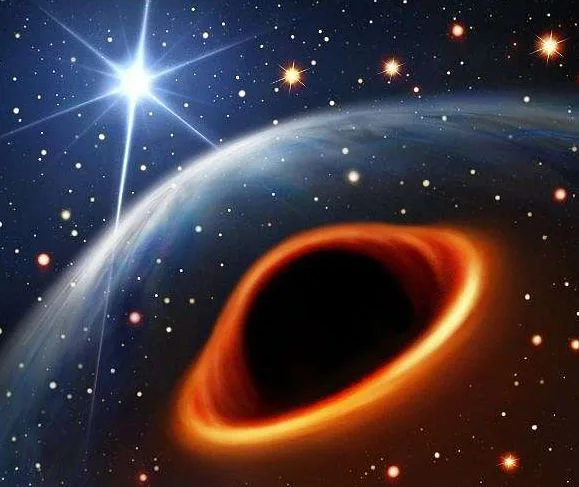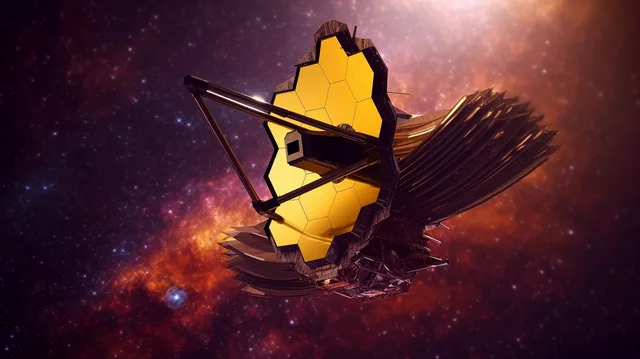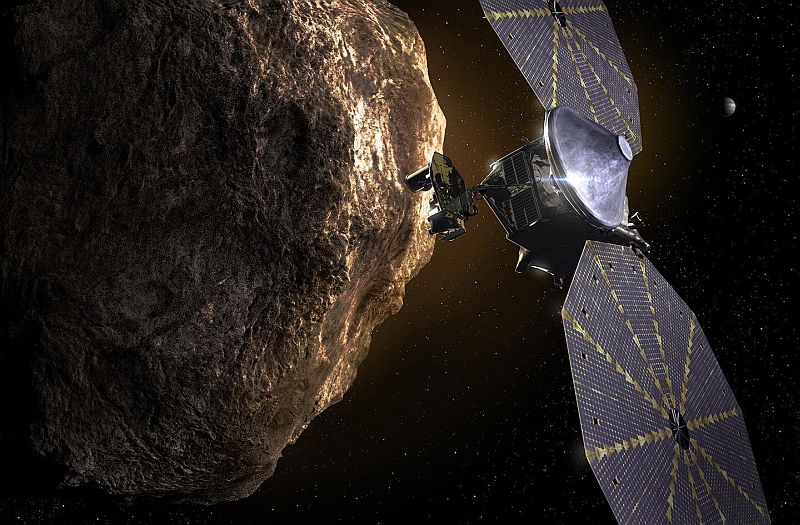
Credit: NASA/Lockheed Martin
COVID-19 coronavirus pandemic has forced the world to halt all its processes. Be it huge corporations or small budget enterprises, everything has come to a standstill.
Under these circumstances, building a spacecraft seems an impossible task. However, scientists at Southwest Research Institute (SwRI) think otherwise.
They have achieved an important milestone by passing its System Integration Review (SIR). Now they are on their way to assemble spacecraft for mission Lucy. It almost took six years to graduate from a proposal to actual flight hardware.
With the SIR now complete, Assembly, Test and Launch Operations (ATLO) activities will commence by September 2020. It is expected to take place at Lockheed Martin Space Systems in Littleton, Colorado.
The Lucy Mission is named after the Lucy fossil, which was discovered in 1970s in Ethiopia. Just like Lucy fossil transformed our understanding of human evolution, the Lucy mission will help us in understanding the evolution of solar system, claimed Cathy Olkin, Deputy Principal Investigator, Southwest Research Institute.
Voyages of exploration
Under a Discovery Program in 2015, Lucy was selected as one of the five finalists for in-depth conceptualization studies. Eventually, in 2017, two missions were picked up for flight:
- Lucy and
- the Psyche asteroid orbiter
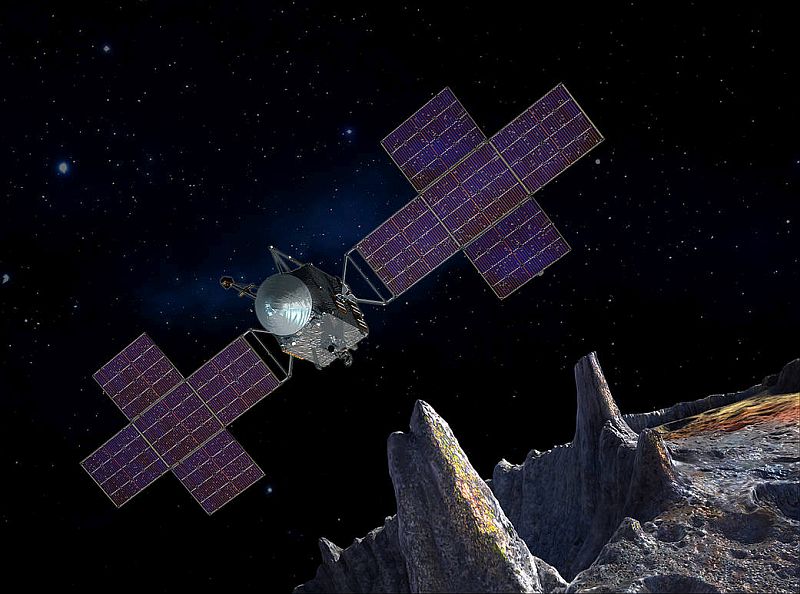
Credit: NASA
The Psyche mission is a journey to a unique metal asteroid orbiting the Sun between Mars and Jupiter. Aim of this mission is to explore the origin of planetary cores by studying the metallic asteroid 16 Psyche. It appears to be the exposed nickel-iron core of an early planet, one of the building blocks of our solar system.
As of 2017, Lucy and Psyche, are the thirteenth and fourteenth missions under the Discovery Program series. US National Aeronautics and Space Administration (NASA) has funded almost all Solar System exploration missions through its Planetary Missions Program Office.
Lucy Mission
Lucy will be the first space voyage to explore a population of small bodies called the Trojans.
Trojan asteroids are interesting population of small bodies left over from the formation of planets. Thus, serve as time capsules from the birth of our Solar System over 4 billion years ago.
They lead or follow Jupiter by roughly 60 degrees. These Asteroids fall between the gravitational force of Sun and Jupiter, which also makes them stable ‘forever’. The stable Lagrange points is labelled L4 and L5.
These Trojans or the primitive bodies provide a unique sample of the remnants of planet formation. In fact, these objects haven’t changed much since the time the planets assembled themselves. Hence, studying them can provide an in-depth analysis of the fundamental questions like:
- The physical conditions of early solar system
- How planets grew
- Formation of early solar system
- What led to the evolution?
- How they moved along
- What was the basic element?
- The origins of organic materials—and even life—on Earth
Mission Targets
Lucy will tour six Trojan asteroids and one main belt asteroid. The launch is planned for October 2021. It will take two rotation along Earth’s orbit and finally a sling shot to enter into the Jupiter’s orbit for the Trojan Asteroids.
On its way out to the Trojan asteroids, Lucy will travel through the main asteroid belt and fly by its first asteroid on April 2025. It will fly by the inner main-belt asteroid (52246) Donaldjohanson, an asteroid that the Lucy team named after one of the co-discoverers of the Lucy fossil.
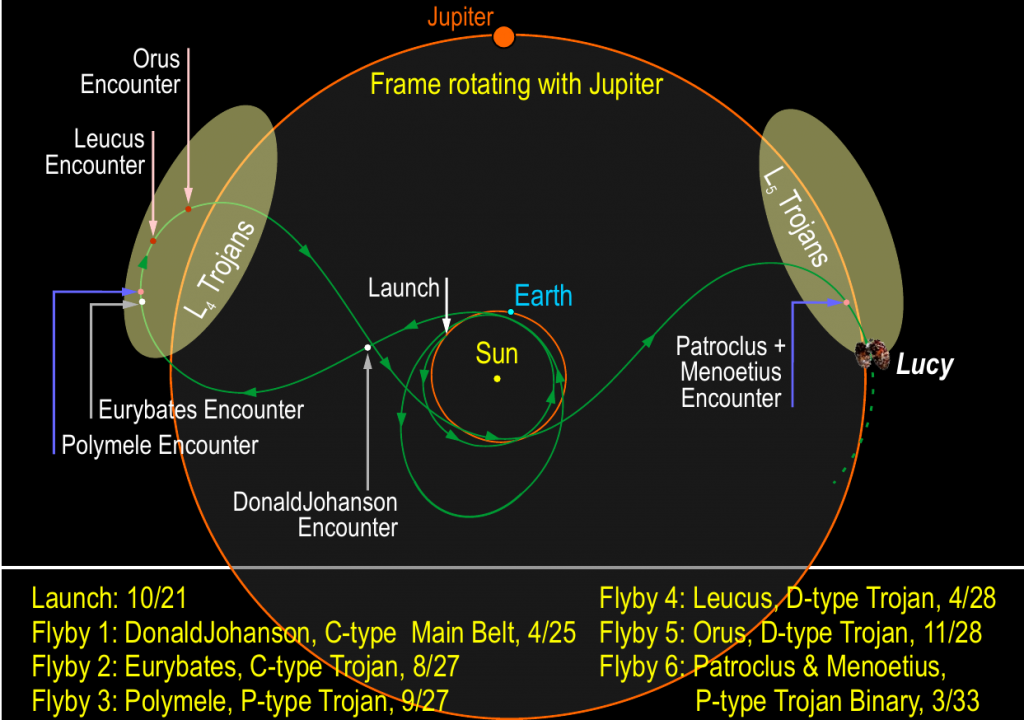
Credit: NASA/Lucy Mission
It will arrive at Jupiter’s L4 Trojan cloud in 2027 to visit
- (3548) Eurybates
- (15094) Polymele
- (1351) Leucus and
- (21900) Orus
After an Earth flyby, Lucy will arrive at the L5 Trojan cloud (trails behind Jupiter) to visit the (617) Patroclus−Menoetius binary in 2033. They are nearly identical in size with a common center of mass and are orbiting one another.
The Spacecraft and Payload
Lucy will be over 45 feet with each solar panel of about 20 feet in diameter. Role of the huge solar panels is to give power to the spacecraft as it flies out the orbit of Jupiter.
Generally, there are three power sources from which a spacecraft gets its energy. They are:
- the Sun
- batteries or
- unstable atoms
Satellites that hover the Earth’s orbit are close to the sun so they have solar panels for solar energy. In addition, spacecraft on Mars also makes use of solar power. All NASA’s Mars Exploration Rovers are embedded with solar panels including:
- The twin rovers – Spirit and Opportunity
- Phoenix lander
- InSight lander
Juno spacecraft that orbit Jupiter also uses solar power. Each of Juno’s three solar arrays is 30 feet long.
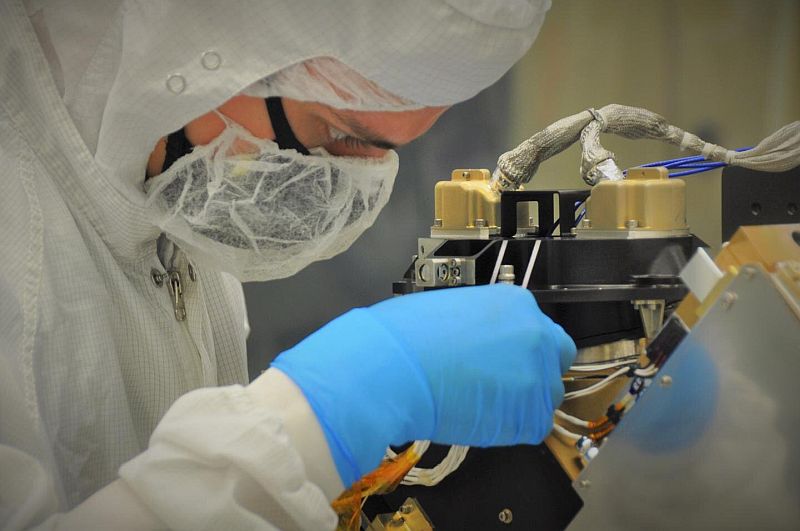
Credit: NASA/GSFC
Lucy’s instruments
Lucy will carry the following four instruments for remote-sensing science on its spacecraft body, which is much smaller than the solar panels.
- L’Ralph: it is the color visible imager. It will help to determine how active Trojan asteroid targets are.
- L’LORRI: it is the high spatial resolution visible imager. It will provide the most detailed images of the surface of the Trojans.
- L’TES: it is the Thermal Emission Spectrometer. It will assist in determining the properties of the Trojans such as their thermal inertia, that is, how well the bodies retain heat. It will help in understanding the composition and structure of material on the surface of the asteroids.
- High Gain Antenna: it will help to determine the masses of the targets using the Doppler shift of the radio signal.
Science objectives
Lucy will fly by and carry out remote sensing on six different Trojan asteroids to address the following science objectives:
Surface Geology – Lucy will map the radiation that is being reflected by the surface, form, crater spatial and size-frequency distributions, to determine the nature of crustal structure and layering. This will help to identify the relative ages of surface units.
Surface Color and Composition – In order to ascertain the distribution of minerals, ices, and organic species, the spacecraft will map the color, composition and regolith properties of the surface of the Trojan asteroid.
Interiors and Bulk Properties – Lucy will determine the masses and densities, and study sub-surface composition via excavation by craters, fractures, ejecta blankets, and exposed bedding.
Satellites and Rings – it will also search for rings and satellites of the Trojan asteroids.
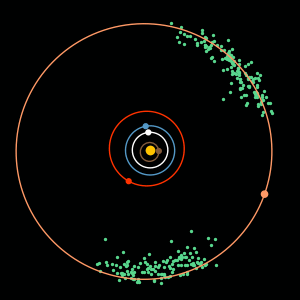
The takeaway
The Trojan asteroids are the left-over of planet formation hence, they are valuable assets as they tell us the origin of solar system. A question that astronomers have been trying to answer since very long.
Space scientists have high hopes from Lucy Mission. With telescopes, even with Hubble, surface details are not easily rendered. Lucy will be going to play a pivotal role in helping us understand what these asteroids are made up and how they look like.
Via: NASA/Lucy Mission


